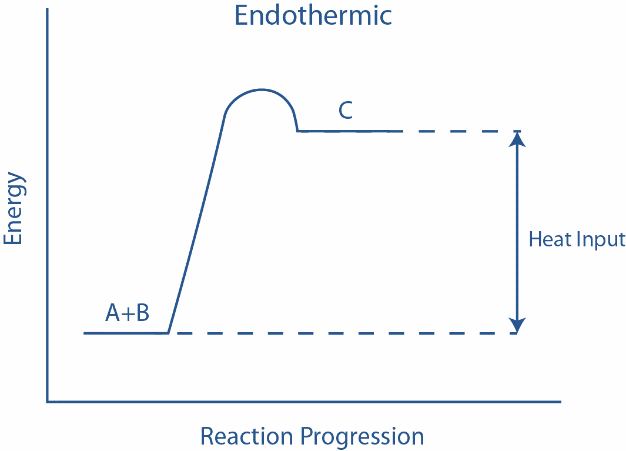
A reaction that occurs only when heat is added is best described as:
A. Exothermic
B. Endothermic
C. An equilibrium process
D. Spontaneous
E. Non-spontaneous
Answer
124.8k+ views
Hint: Chemical reaction is a process in which one or more substances are converted to more different substances. Substances may be either chemical elements or compounds. Some reactions may involve energy changes, like absorption of heat energy etc.
Complete step by step answer:
An endothermic reaction is a chemical reaction in which more energy is needed to break bonds in the reactants than the energy released when new bonds are formed in the form of products. These are basically the reactions in which the reactants absorb heat energy from the surroundings to form products. This reaction occurs only when the heat is added.
Moreover, these reactions lower the temperature of their surrounding area, thereby creating a cooling effect.

Now, in the given picture, the energy tied up in the molecular bonds is greater in the products than in the reactants. However, there is a need for the activation energy to commence the reaction but, once that hurdle is overcome, the reaction proceeds resulting in the formation of product C and the resulting product has more bond energy than the reactants. Some examples of endothermic reactions are melting of ice to form water, sublimation of solid $C{O_2}$ , baking of bread, evaporation of liquid water to form water vapor etc.
Hence, option B is correct.
Note: For exothermic reactions, the potential energy of the product is generally lower than that of the reactants. On the other hand, the potential energy of the product in an endothermic reaction is higher than that of the reactants.
Complete step by step answer:
An endothermic reaction is a chemical reaction in which more energy is needed to break bonds in the reactants than the energy released when new bonds are formed in the form of products. These are basically the reactions in which the reactants absorb heat energy from the surroundings to form products. This reaction occurs only when the heat is added.
Moreover, these reactions lower the temperature of their surrounding area, thereby creating a cooling effect.

Now, in the given picture, the energy tied up in the molecular bonds is greater in the products than in the reactants. However, there is a need for the activation energy to commence the reaction but, once that hurdle is overcome, the reaction proceeds resulting in the formation of product C and the resulting product has more bond energy than the reactants. Some examples of endothermic reactions are melting of ice to form water, sublimation of solid $C{O_2}$ , baking of bread, evaporation of liquid water to form water vapor etc.
Hence, option B is correct.
Note: For exothermic reactions, the potential energy of the product is generally lower than that of the reactants. On the other hand, the potential energy of the product in an endothermic reaction is higher than that of the reactants.
Recently Updated Pages
The hybridization and shape of NH2 ion are a sp2 and class 11 chemistry JEE_Main

Total number of orbitals associated with the 3rd shell class 11 chemistry JEE_Main

Which of the following has the lowest boiling point class 11 chemistry JEE_Main

Which of the following compounds has zero dipole moment class 11 chemistry JEE_Main

Number of g of oxygen in 322 g Na2SO410H2O is Molwt class 11 chemistry JEE_Main

In the neutralization process of H3PO4 and NaOH the class 11 chemistry JEE_Main

Trending doubts
JEE Main 2025 Session 2: Application Form (Out), Exam Dates (Released), Eligibility & More

JEE Main Exam Marking Scheme: Detailed Breakdown of Marks and Negative Marking

JEE Main 2023 January 24 Shift 2 Question Paper with Answer Keys & Solutions

Learn About Angle Of Deviation In Prism: JEE Main Physics 2025

JEE Main 2025: Conversion of Galvanometer Into Ammeter And Voltmeter in Physics

JEE Main Login 2045: Step-by-Step Instructions and Details

Other Pages
NCERT Solutions for Class 11 Chemistry Chapter 7 Redox Reaction

NCERT Solutions for Class 11 Chemistry Chapter 5 Thermodynamics

JEE Advanced Marks vs Ranks 2025: Understanding Category-wise Qualifying Marks and Previous Year Cut-offs

NCERT Solutions for Class 11 Chemistry Chapter 8 Organic Chemistry

NCERT Solutions for Class 11 Chemistry Chapter 6 Equilibrium

NCERT Solutions for Class 11 Chemistry Chapter 9 Hydrocarbons




